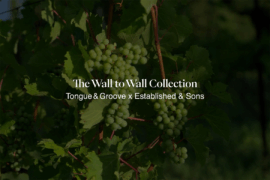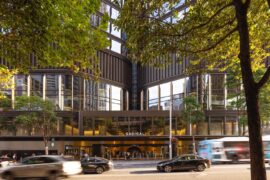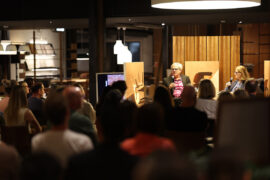Architectus has designed new interiors for Allianz with an astute understanding of the modern workplace, where architecture, nature and technology converge to create an agile environment.

Photography by Christopher Frederick Jones
December 10th, 2024
In a bold departure from conventional corporate environments, Architectus has conceived two workplace interiors for Allianz Australia in Brisbane and Adelaide in a bold departure from conventional corporate environments. These fit-outs examine contemporary workplace design, integrating advanced biophilic strategies, spatial ergonomics and a human-centric approach that reconsiders the way employees experience their workspaces. “We have sought to design environments that beckon employees back, fostering a sense of belonging and connectedness,” explains Troy King, Principal of Architectus.
Spatial choreography is at the fore of the respective designs, with the aim of supporting movement and interaction. The central staircase is orientated back-of-house, shifting the paradigm of conventional office circulation. This design move consolidates social and respite zones, converting the stairwell into a vertical connector that serves as a thoroughfare and a communal gathering point, elevating the spatial narrative around inter-floor connectivity.

The design vocabulary of the Brisbane office is marked by its composition of biophilic principles. Architectus harnesses natural light as a design tool, drawing it deep into the workspace to animate the interiors with a softened, organic ambience. The layout creates workstations that hug the periphery, maximising access to daylight and external vistas, and fostering a subtle and powerful connection between the built form and the natural environment. This relationship is strengthened by the palette of organic materiality employed through timber veneers, natural stone and biomorphic patterns in carpeting.
An outdoor terrace acts as an extended landscape intervention, blurring the lines between interior and exterior realms. This spatial extension offers a compelling amenity for staff to recharge within the precinct itself. The terrace, integrated with soft landscaping and adaptable outdoor seating, introduces a vital breath of fresh air — literally and architecturally — into the office landscape.


The lighting strategy amplifies the human-centric focus, with task and ambient lighting systems designed to be fully controllable. The warm, domestic quality of the lighting palette echoes residential typologies and humanises the space, reinforcing comfort and calmness amidst the professional setting. Architectus’ sensitivity to lighting design avoids the rigidity of typical office illumination, opting instead for a nuanced approach that fosters a layered atmosphere.
In Adelaide, the design asserts its own identity, while maintaining the ethos of wellness and connectivity. Architectus Principal Andrew Schunke emphasises the spatial dynamism achieved through the ‘central street’, which bisects the floorplate, creating a high-energy axis around which collaborative zones and retreat spaces revolve. “The central street that links the different areas is vibrant, and invigorating,” says Schunke. The interplay of colour and form on this axis reinforces spatial hierarchy, with vibrant hues energising social zones and calmer tones employed in areas intended for respite.
Related: Architectus in Ethiopia

Material tactility, again, plays a pivotal role in the Adelaide model, with the integration of natural timbers and soft landscaping generating a sensory engagement with the space. The biophilic framework is enriched by the inclusion of First Nations artisans, whose woven installations activate the stair void, imbuing the interior with cultural narratives and contextual depth. These suspended sculptural forms, coupled with bold, earth-toned artworks, create a dialogue between art, architecture and the workplace — elevating the experience beyond the utilitarian.
Mutually, the designs employ a robust integration of workplace technology, embedding wireless connectivity and adaptable workstations within the design fabric. The spatial programming maximises the fluid transition between individual workstations, meeting spaces and collaborative zones. The office becomes a responsive ecosystem, where employees are empowered to move between spaces, aligning with the demands of a hybrid workforce. Gwendy Arnot, General Manager of Allianz Workplace Services concludes: “We have created an environment that supports hybrid working while placing employee wellbeing at the forefront.”
Architectus
architectus.com.au
Photography
Christopher Frederick Jones, Pixel Collective





INDESIGN is on instagram
Follow @indesignlive
A searchable and comprehensive guide for specifying leading products and their suppliers
Keep up to date with the latest and greatest from our industry BFF's!

London-based design duo Raw Edges have joined forces with Established & Sons and Tongue & Groove to introduce Wall to Wall – a hand-stained, “living collection” that transforms parquet flooring into a canvas of colour, pattern, and possibility.

For Aidan Mawhinney, the secret ingredient to Living Edge’s success “comes down to people, product and place.” As the brand celebrates a significant 25-year milestone, it’s that commitment to authentic, sustainable design – and the people behind it all – that continues to anchor its legacy.

Rising above the new Sydney Metro Gadigal Station on Pitt Street, Investa’s Parkline Place is redefining the office property aesthetic.

He’s the Director of Eames Office and an all-round creative polymath – and Eames Demetrios has just been in our region with Living Edge.
The internet never sleeps! Here's the stuff you might have missed

Sydney Open invites the public to explore over 55 buildings, spaces and new additions to the skyline, with a newly released Talks & Tours program offering direct access to the architects behind Bundarra and Pier Pavilion.

With a date now set for January 2026, Sydney’s landmark project is taking shape as a significant and welcome addition to civic life in the city.

Central Station by Woods Bagot in collaboration with John McAslan + Partners has been named one of two joint winners of The Building category at the INDE.Awards 2025. Recognised alongside BVN’s Sirius Redevelopment, the project redefines Sydney’s historic transport hub through a transformative design that connects heritage with the demands of a modern, growing city.